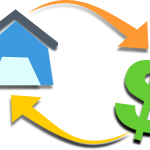There are several refinancing downsides, and you will get into big trouble if you try to remortgage your property with eyes closed

Refinancing your home is not always the best option. Your personal situation should be the biggest factor to consider.
But what are some of the refinancing downsides?
You Do Not Plan To Stay in Your Home For Long
When you are considering refinancing your home, one of the major things to note is how long it takes to recover the new loan closing costs. This is known as the break-even period. It is after this period that you start to save money on your new mortgage. You need to know the closing costs and the interest rate on your new loan to calculate the break-even point. If you plan on moving before the break-even period ends, refinancing your property is not a good option for you.
You Can’t Afford Closing Costs
If you cannot afford to pay the closing costs out of pocket, it is not a good idea to refinance your mortgage. There is an option to add the closing costs to your loan and pay it back monthly. Doing this could make your monthly payments so high that you don’t end up making any savings.
Higher Long-term Costs
Consider what the long-term cost of refinancing is if most of the payment you’ve made on your 30-year mortgage covers the interest. Refinancing into a shorter-term mortgage could increase your monthly payments and make it unaffordable for you. Refinancing downsides include savings loss. For example, refinancing into another 30-year mortgage would reduce your monthly payment, but the long-term cost could remove any savings you hope to make.
Pros and Cons of Refinancing Your Home
Pros
When you refinance, you are likely to get a lower interest rate. This would result in lower monthly mortgage payments. You can move from a longer-term loan to a shorter-term loan. If rates are low, you can reduce your interest payments.
Also, you can finish paying off your loan faster and be free of debt sooner. By making monthly mortgage payments over time and making improvements to your home, you build up equity. By refinancing your home, you may be able to pull money from the equity you have built.
Cons
One of the big refinancing downsides is your long-term savings on refinancing your home may be very little or nonexistent. This could happen if you’re refinancing into a longer-term loan, or the closing costs on your new loan are more than you can afford right now. Refinancing your home can take a lot of time. It can be a stressful process, and the savings you make may not be worth it.
Refinancing into a shorter-term loan could result in higher monthly mortgage payments. Although you may be able to afford this now, you cannot tell what your finances would look like in the future. Mortgage refinancing can lower your credit score in a variety of ways. The first of these results from the lenders checking your credit score and credit history, the hard inquiry. This can lower your credit score slightly for a short period. Your credit score can also reduce because you are paying off long-standing credit with a new one.
There are a lot of advantages to refinancing your mortgage. But what about the refinancing downsides? Are there any disadvantages borrowers need to be aware of before taking out that new loan?
As with most decisions in life, there are both positives and negatives to refinancing a mortgage. Even with interest rates as low as they are right now, there are still potential pitfalls to avoid. Fortunately, most of these can be avoided by choosing the right mortgage – only a few are outright deal-breakers.
Here are some of the main things to look out for.
Cost
The number one among the refinancing downsides is that it costs money. What you’re doing is taking out a new mortgage to pay off the old one – so you’ll have to pay most of the same closing costs you did when you first bought the home, including origination fees, conveyancing fees, application fees and closing fees.
These days, you’ll likely have to pay for a new appraisal as well, since most homes have declined in value over the past few years and the new lender will be unwilling to loan you more than the property is worth – they’d rather leave that burden on your current lender!
Refinancing will generally cost you from 2 – 6 percent of the amount borrowed, depending on where you live, though most borrowers tend to pay toward the lower end of that range. The key then, is to make sure you’re saving enough by refinancing to make the transaction worthwhile.
Not saving enough
So how do you know if you’re saving enough by refinancing? If you can recover your closing costs in a reasonable time. If your new mortgage rate is only half a percentage point lower than the old one, it might take 7-10 years to recoup the costs of refinancing.
The way to tell if you’re saving enough is by calculating your “break-even point” – how long it will take your savings from a lower mortgage rate to exceed your closing costs. You can speak to a mortgage broker to help you calculate this point and explain to you what the refinancing downsides are.
You generally want to be able to recoup your costs within five years or so. Many homeowners relocate after 5-7 years in the same property, so if you move before you reach the break-even point, you won’t recover your refinance costs. But if you expect to stay in the home for a long time, you can allow more time to reach your break-even point.
Stretching it out
If you’ve had a 25-year mortgage for a number of years, you probably don’t want to refinance your home into a new 30-year loan. That might lower your monthly payments, but it also postpones the day you own your home free and clear. And because of the way compounding interest works, it could cost you more over the long term, even if you reduce your mortgage rate in the process.
It’s better to choose a 15 or 20-year term that more closely matches the time you have left on your original home loan. And since shorter-term loans have lower mortgage rates, you can often chop a few years off your loan without increasing your monthly payment.
Refinancing is a process that can seem intimidating to some people, but it needn’t be – if anything, it’s simpler than taking out the original mortgage you used to buy the home. But basically, as long as you can lower your mortgage payment enough to recoup your costs in a reasonable time and avoid the other refinancing downsides above, it’s a sound and straightforward financial move to make.






